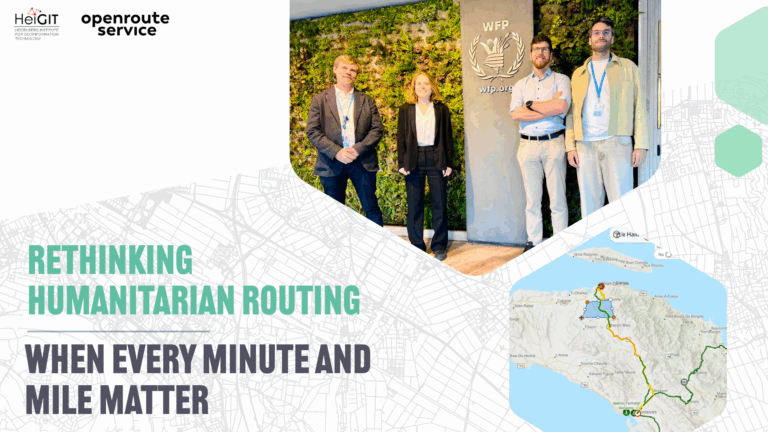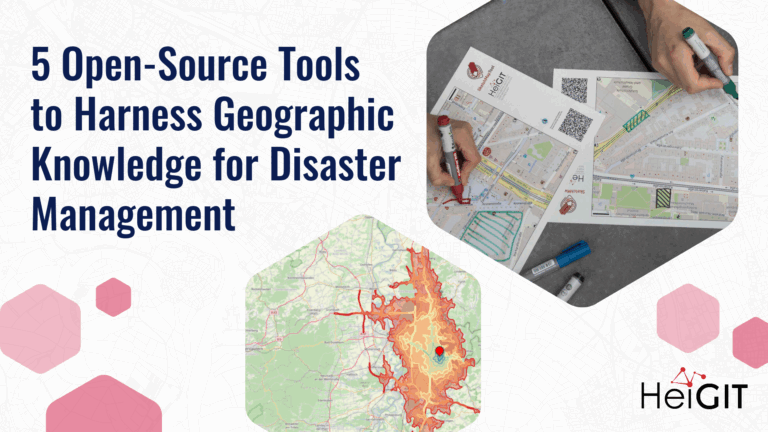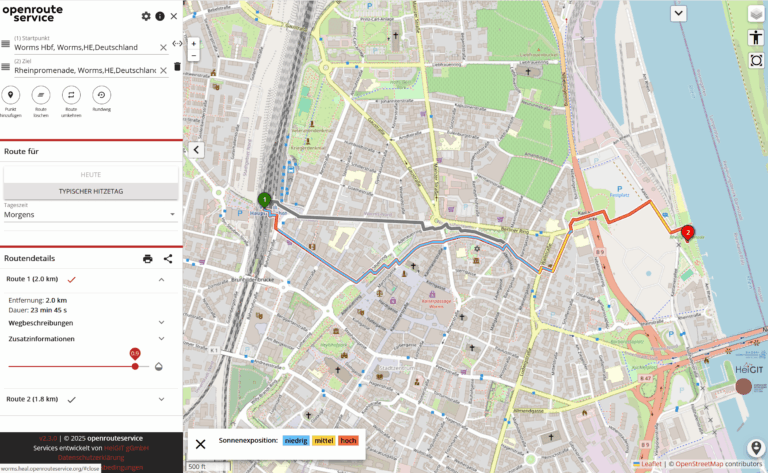The Regionalverband Ruhr (Team 9-2 Geodata Technology) has used the potential of HeiGIT’s openrouteservice (ORS) in a new QGIS extension and thereby created another possible application for the ORS: The tool “Location and Route Optimization of Addresses” allows to search and locate addresses and to find the optimal routes between them.
This is possible not only for one, but for several vehicles: Different vehicles can be defined at the starting points as well as a maximum number of adresses that shall be approached by each vehicle. Optionally, end points of the routes and the length of stay per address can be specified. Thus, the ORS enables routing for complex and possibly time-bound operations and guarantees the greatest possible work efficiency. The driving instructions can then be exported as a PDF file for the respective vehicles and routes (the Print Layout plugin must be imported for this). Especially during the Corona pandemic, with the help of ORS, the tool can thus provide important support for the municipalities of the Geonetzwerk.metropoleRuhr.
In addition to route finding, the QGIS extension also offers the following functions:
- Searching addresses. Currently, a full text search for addresses is possible. The extension suggests concrete results based on keywords for street and city, from which the desired locations can be selected. The data in the respective area is updated monthly and in the future, it will also be possible to suggest points of interest.
- Location of addresses. Addresses can be read from an Excel file and located as a point layer in QGIS, provided that the table has an “address” section in which the character string of the address (street, house number and city) is listed.
More information about the extension as well as a detailed and illustrated application guide can be found at:
https://hilfe.geoportal.ruhr/openrouteservice/overview/index.html
Further information on HeiGIT’s OpenRouteService can be found at:
You can find information about parameters in our interactive documentation, and you can sign up for a free API key on our developer dashboard. Openrouteservice is serving the OSM community and more already since 2008 . Further details can be found in the openrouteservice GitHub repository, while more news concerning openrouteservice can be found under http://giscienceblog.uni-hd.de/tag/openrouteservice/.
—————-
Further News (Selection):
- All countries of South and Southeast Asia now on Open Healthcare Access Map
- All countries of Sub-Saharan Africa now in Open Healthcare Access Map
- New mFund project: start of SocialMedia2Traffic – derivation of traffic information from social media data
- A fresh new ORS maps client
- Find the route to your nearest Covid-19 vaccination center in Germany — new App by HeiGIT based on OpenStreetMap and openrouteservice
- New embedded mode for OpenRouteService map client available
- German Mass Vaccination Sites in Open Healthcare Access Map
- Flood Impact Assessment on Road Network and Healthcare Access at the example of Jakarta, Indonesia
- Karlsruhe relies on openrouteservice – ESRI client plugin developed
- Going green with MeinGrün – Today App launch in Heidelberg and Dresden
- NASA uses Openrouteservice for study on disaster response times
- OpenRouteService with waypoint optimization
- Accessibility of covid-19 vaccination centers in Germany
- Introducing the Open Healthcare Access Map
- Access to Health Care using openrouteservice Isochrones API
- Disy integriert openrouteservice in Cadenza
Literatur (Auswahl):
- Neis, P. & Zipf, A (2008): OpenRouteService.org is three times “Open”: Combining OpenSource, OpenLS and OpenStreetMaps. GIS Research UK (GISRUK 08). Manchester.
- Ludwig, C., S. Fendrich, T. Novack, S. Marx, A. Oleś, S. Lautenbach, A. Zipf (2020): Optimal ans Ziel: Routing-Dienste auf Basis nutzergenerierter Geodaten – Herausforderungen und Lösungsansätze für globale Datensätze, In: Zagl, Loidl (Hrsg.): Geo-IT in Mobilität und Verkehr, Geoinformatik als Grundlage für moderne Verkehrsplanung und Mobilitätsmanagement. VDE Wichmann Verlag. S. 89-106.
- Novack, T.; Wang, Z.; Zipf, A. (2018): A System for Generating Customized Pleasant Pedestrian Routes Based on OpenStreetMap Data. Sensors 2018, 18, 3794.
- Rousell A. and Zipf A. (2017): Towards a landmark based pedestrian navigation service using OSM data. International Journal of Geo-Information, ISPRS IJGI, 6(3): 64.
- Zipf, A., Mobasheri, A., Rousell, A. ,Hahmann, S. (2016): Crowdsourcing for individual needs – the case of routing and navigation for mobility-impaired persons . In: Capineri, C, Haklay, M, Huang, H, Antoniou, V, Kettunen, J, Ostermann, F and Purves, R. (eds.) European Handbook of Crowdsourced Geographic Information, p. 325–337. London: Ubiquity Press. DOI: dx.doi.org/10.5334/bax.x
- Wang, Z., T. Novack, Y. Yan and A. Zipf, “Quiet Route Planning for Pedestrians in Traffic Noise Polluted Environments,” in IEEE Transactions on Intelligent Transportation Systems, doi: 10.1109/TITS.2020.3004660.
- Neis, P., Singler, P. & Zipf, A. (2010): Collaborative mapping and Emergency Routing for Disaster Logistics – Case studies from the Haiti earthquake and the UN portal for Afrika. In: Car, A., Griesebner, G. & Strobl, J. (Eds.): Geospatial Crossroads @ GI_Forum ‘10. Proceedings of the Geoinformatics Forum Salzburg.
- Miksch, J., Hahmann, S., Resch, B., Lauer, J., Zipf, A. (2017): Routing Through Open Spaces – A Performance Comparison Of Algorithms. Geo-Spatial information Science, 2017. Taylor & Francis. Geo-Spatial information Science, 2017. Taylor & Francis. https://doi.org/10.1080/10095020.2017.1399675




